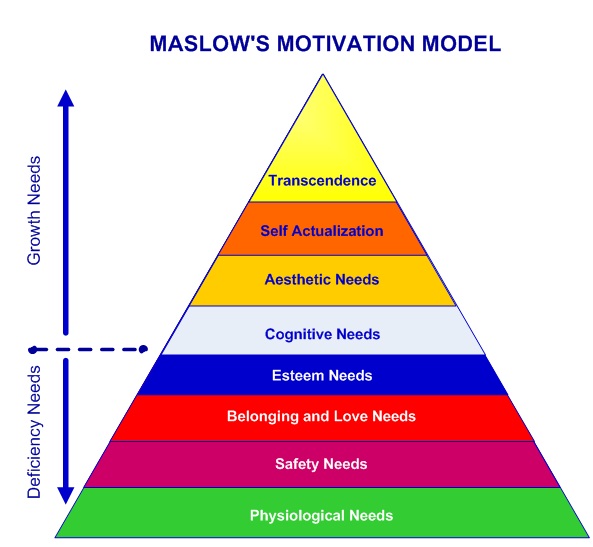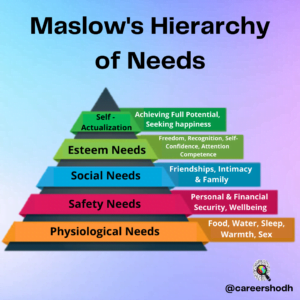Abraham Maslow is well known for Maslow’s Need Hierarchy Theory of Motivation. The theory includes basic 5 levels of needs. Non-fulfillment of these needs motivates a being to take action and fulfill them. Thus, any human works in order to satisfy these needs. Therefore, this is an important aspect of Motivation. Moreover, Maslow’s Need Hierarchy Theory of Motivation is a part of the humanistic approach to study motivation. Let’s get familiar with all these terms first.
Contents
What is Motivation?
Motivation is defined as a hypothetical process inferred from certain changes in responses taking place as a consequence of certain changes in the stimulus.
Motivation is the process by which activities are started, directed, and continued so that physical or psychological needs or wants are met (Petri, 1996).
In fact, the word itself comes from the Latin word movere, which means “to move.” Motivation is what “moves” people to do the things they do. For example, A person is relaxing in front of the television and begins to feel hungry. Thus, the physical need for food might cause the person to get up, go into the kitchen, and search for something to eat.
Humanistic Approach to Motivation
Humanistic theories of motivation are based on the idea that people also have strong cognitive reasons to perform various actions. Hence, Maslow’s Need Hierarchy Theory of Motivation is strongly based on this humanistic approach. In fact, this theory is one of the laying bricks in humanistic approach.
What is a Hierarchy?
A hierarchy is a system of organizing entities into different ranks or levels of importance.
‘The hierarchy of needs’ refers to the concept of sequence of particular needs given by Abraham Maslow.
Maslow’s Need Hierarchy Theory of Motivation
Abraham Maslow developed the theory of hierarchy of needs. It suggests that individual needs exist in a hierarchy consisting of –
- Physiological needs
- Security needs
- Belongingness needs
- Esteem needs
- Self-actualization needs.
Eventually, Maslow structured these needs into a pyramid form, thus, building a hierarchy. The hierarchy flows from bottom to top.
Physiological Needs:
These include the most basic needs that are vital to survival. Such as the need for water, air, food and sleep. Maslow believed that these needs are the most basic and instinctive needs in the hierarchy. In fact, all needs become secondary until an individual meets these physiological needs.
- Homeostasis
- Food
- Water
- Sleep
- Warmth
- Sex
Until and unless a person satisfies these needs, his / her body cannot function optimally. Moreover, a person cannot fully move on to the next level of needs without fulfilling the primary needs. For example, an individual may find it difficult to focus on his job / studies due to inadequate sleep.
Security Needs:
These include needs for safety and security. Security needs are important for survival, but they are not as demanding as the physiological needs.
- Steady employment
- Financial security
- Emotional security
- Overall wellbeing
- Health insurance
- Safe neighborhoods
- Shelter from the environment.
Neglect of these needs cause post-traumatic stress.
Social Needs:
These include needs for belonging, love and affection. Maslow considered these needs to be less basic than physiological and security needs.
- Friendships
- Romantic attachments
- Families
- Companionship
- Acceptance
- Community
People deprived of these needs often suffer from anxiety and depression. In addition, lack of affection and belongingness may lead to increased violence and crime.
Esteem Needs:
After the first three needs have been satisfied, esteem needs becomes increasingly important. Esteem needs signify our place in the community. Hence, a person must fulfill these needs to feel confident and competent.
- Personal worth
- Social recognition
- Sense of accomplishment
- Freedom & Independence
- Attention
- Competence
- Self – Confidence
Lack of self esteem may cause anxiety and depression. It induces insecurities and self sabotage.
Self-actualising Needs:
Self – actualization refers to the need of achieving one’s full potential. This is the highest level of Maslow’s Need Hierarchy Theory of Motivation Therefore, it is believed that once a person has completely entered the spectrum of self – actualization, the other needs do not have much value.
- Self-aware
- Concerned with personal growth
- Less concerned with the opinions of others
- Interested fulfilling their potential
- Parenting
- Pursuing a goal
- Utilizing talents and abilities
- Seeking happiness
Maslow recognized that an employee’s behavior is motivated simultaneously by several need levels. However, behavior is motivated mostly by the lowest unsatisfied need at the time. Thus, as the person satisfies a lower-level need, the next higher need in the hierarchy becomes the primary motivator. Therefore, this concept is known as the satisfaction-progression process.
Even if a person is unable to satisfy a higher need, he or she will be motivated by it until it is eventually satisfied. Physiological needs are initially the most important, and people are motivated to satisfy them first. Further, as they become gratified, safety needs emerge as the strongest motivator. Consequently, as safety needs are satisfied, belongingness needs become most important, and so forth.
However, the exception to the satisfaction-progression process is self-actualization. As people experience self-actualization, they desire more rather than less of this need.
Deficit vs. Growth Needs
Deficit or Deficiency needs
arise from deprivation or neglect of needs. These deficit needs, when unmet, motivate people to fulfill them. Thus, the intensity of this motivation to fulfill the need is directly proportional to the duration that need is denied.
For example, the longer a person is hungry, stronger will be his/her desire to eat.
Physiological, Security, Love & Belongingness and Esteem needs are deficit needs.
Growth Needs
are not rooted in deprivation or lack of something. In fact, it is something that motivates an individual to grow as a person.
Self – actualization is a growth need.
Revisions in the Hierarchy (8 stage model)
Maslow kept updating and revising his theory. In addition, he updated the model of hierarchy, too. The eight-stage model includes all the five needs from the primary five stage model and the newly included – Cognitive, Aesthetic and Transcendence needs.

Maslow’s Hierarchy of Needs – 8 Stage Model
Criticism of Maslow’s Need Hierarchy Theory of Motivation
Maslow’s theory has had a powerful influence on the field of management (Heil et al., 1998) In spite of this influence, Maslow’s theory is not without its critics. There are several problems that others have highlighted. The most
serious is that there is little scientific support (Drenth et al., 1984). Like Sigmund Freud, Maslow developed his theory based on his personal observations of people. However, it would have been more evident if it was empirically gathered observations or research.
Although many people report that while they were starving, they could think of nothing but food, there is anecdotal evidence in the lives of many people, some of them quite well known, that the lower needs do not have to be satisfied before moving on to a higher need (Drenth et al., 1984).
For example, artists and scientists throughout history have been known to deny their own physical needs while
producing great works (a self-actualization need). In addition, Maslow’s work was also based on his studies of Americans. Cross-cultural research suggests that the order of needs on the hierarchy does not always hold true for other cultures.
Maslow’s needs hierarchy is one of the best-known organizational behavior theories. However, the model is much too rigid to explain the dynamic and unstable characteristics of employee needs. In fact, researchers have found that individual needs do not cluster neatly around the five categories described in the model. Moreover, gratification of one need level does not necessarily led to increased motivation to satisfy the next higher need level.
To check your understanding of the topic, take this short test – MCQ test on Maslow’s Hierarchy of Needs
References
- Ciccarelli, S. K.; White J. N. Adapted by Girishwar Misra (2018). Psychology (5th Edition). Pearson.
- egyankosh.ac.in

